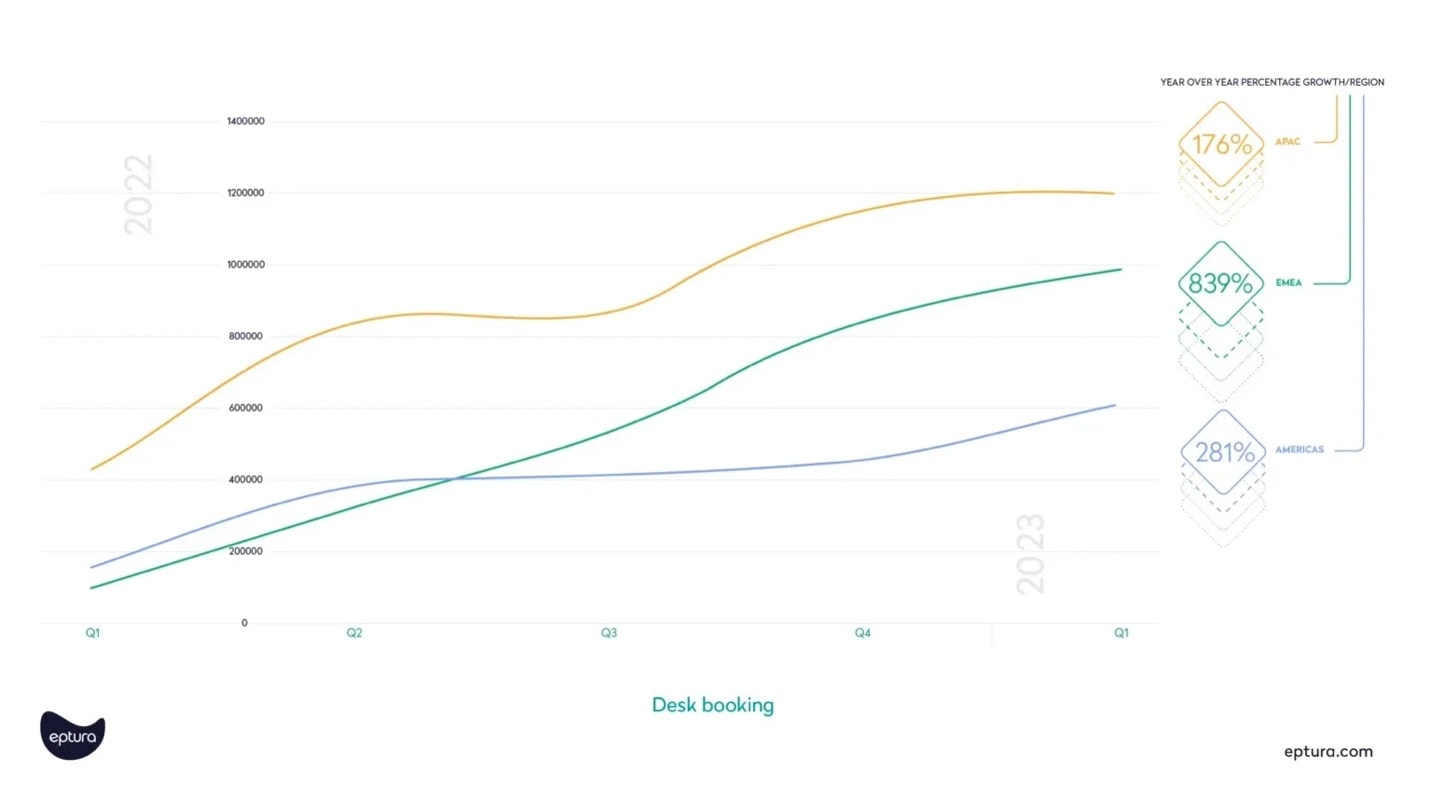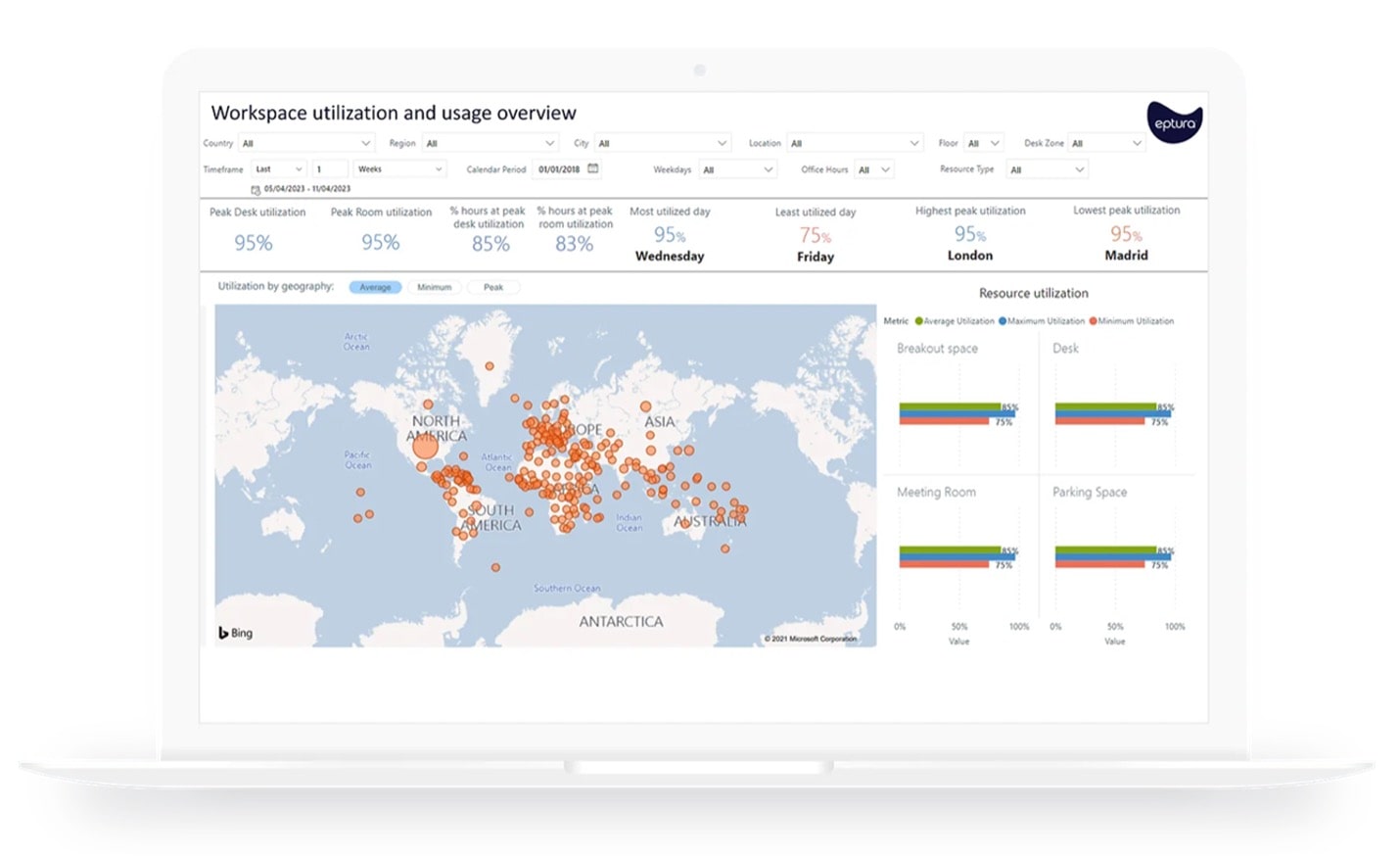
What does it mean to be a data-driven organization? And are there any differences between being data enabled vs data driven?
There’s no shortage of data within organizations. Per Statista, enterprise data grew at a rate of 42% between 2020 and 2022 – for a total of 2.02 petabytes.
But did you know only about a third (32%) of all data that’s available to enterprises is put to work? The remaining 68% is being unleveraged, according to IDC research. Just because you have all this data doesn’t necessarily mean it’s being put to good use.
The days of the real estate footprint being a static asset are in the past. Real estate professionals today are treating data as an asset – especially in today’s dynamic world of hybrid work.
To hit the operational efficiency targets, gain competitive advantage, or to improve business processes and customer experiences, embracing data driven transformation is a lot more than a business school buzzword. Let’s take a closer look at the key characteristics of what it means to be data driven in today’s global workplace.
1. A data-driven culture is anchored by leadership
It’s a shift in mindset. Leaders need to lead and model the behavior they want to see with employees using metrics and analytics. David Waller, a partner and the head of data science and analytics for Oliver Wyman Labs, explains the importance of leading by example in his Harvard Business Review article “10 Steps to Creating a Data-Driven Culture”:
“Companies with strong data-driven cultures tend have top managers who set an expectation that decisions must be anchored in data — that this is normal, not novel or exceptional … These practices propagate downwards, as employees who want to be taken seriously have to communicate with senior leaders on their terms and in their language. The example set by a few at the top can catalyze substantial shifts in company-wide norms.”
2. Data is easily accessible for everyone
Operational efficiencies can happen at larger scale and with greater impact than automation alone when data is accessible for a larger group of people in the organization. Eliminating manual and paper-based processes are clear benefits of digital transformation but they’re not the only things.
Accessible data can bring better decision-making, reduce risk, improve customer experiences, help stay in compliance, reveal new processes, and offer transparency where it didn’t exist before allowing more predictability. Access to useful data can even allow you to discover new services and offerings.
“What’s above the surface is important, but behind the scenes is where the true magic happens,” reflects Jonathan Cardella, a technology entrepreneur, and founder and chairman of Ventive, in the Forbes article “Accessible Data: The Surprising Digital Transformation Benefit That Executives Are Missing.”
“Here lives the most underrated but indispensable benefit of digital transformation—data accessibility,” he says. “Enhanced data quality and organizational trust in data enables a 360-degree view of operational processes and customers and drives improvement in critical KPIs for businesses.”
3. There’s a difference between being data enabled vs data driven – and a competitive advantage when paired with management practices
What do we mean by being data enabled? It means you have data and are using it to track and report on conditions.
Being data driven is the integration of data into business processes. It means you are leveraging data to continuously improve business decisions, evolve processes, and adapt skillsets to reach an objective.
The facts are clear. Data-driven organizations perform better than competitors and are better equipped to meet the needs of business users and customers. A Forrester Consulting study found companies which rely on data management tools to make decisions are 58% more likely to beat their revenue goals than non-data-driven companies. And data-driven organizations are 162% more likely to significantly surpass revenue goals than laggards.
Moreover, organizations that use data have a 173% advantage in efficiently complying with regulations compared to non-data driven companies, per Forrester. On the flip side, companies with less data maturity are 55% less likely to say internal data management strategies lead to optimal business decisions.
4. Data is used to find more certainty in an uncertain future of work
It’s a real challenge to find more predictability in space planning without accurate utilization metrics. Utilization means behavior. Behavior means people. And workplace behavior today has undergone big shifts toward more workplace freedom for many employees. At the same time, our need to work together – to be part of a team – and to bond with others in our work is an undeniably important part of a strong workplace culture.
So the real question is: When are your employees coming into the office? How consistent is the pattern? Understanding actual use versus intended use becomes central to answering these questions. And a digitally enabled workplace and the all the space within it is essential.
Hybrid and remote work are having a major effect on building and office moves, vendor management and contracts, ESG standards, regulatory compliance, and inventory management.
When hybrid work models are managed well, they can save time and energy, and boost employee morale and productivity. If they are done poorly, they can shrink a department’s budget and leave an incomplete picture of the workplace. Data is essential to understanding regional differences – especially for global companies.
Per Condeco by Eptura research, all regions spanning Asia Pacific (APAC), Europe, the Middle East, and Africa (EMEA) and Americas saw year over year increases in desk bookings from all of 2022 through the first quarter of 2023:

When you’re able to track and see what’s being reserved compared to what is actually being used – at global scale – you’ll have a better understanding of the space changes and office improvements you can make by region.
See all of the data charted in the full report.
5. Data opens and unlocks technology and process siloes
Data helps companies right-size their floorplans and real estate portfolio to match demand while simultaneously managing the costs of building out the right experience to attract people into the office.
A recent poll we conducted for our Q1 2023 Workplace Index report finds about a third of organizations don’t have the right data to understand their space needs.
• 40%: Too much space
• 31%: Need more information to understand
• 29%: Not enough space
When data from facility management systems is integrated and harmonized with data from workplace systems, businesses can find the right balance between the function of a workplace and the operation of the building.
Goodbye, guesswork. See exactly how office space is being used today.
Get greater visibility into work environments and utilization trends with Condeco Analytics Advanced. Make data-driven decisions faster and with more accuracy.
No more tiny columns and rows of numbers in a spreadsheet. Time for rich dashboards using data in context directly within the workplace scheduling system you already use. Say yes to dynamic data.
You can now:
- Gain in-platform workplace intelligence, eliminating the need to export and manipulate data in third-party tools
- Uncover multiple dimensions of data to understand strategic and more granular drivers of workplace utilization and occupancy across all resources and locations
- Customize views by timeframe, office location, resource type, floors and office hours to measure behaviors
- Produce data-driven insights into historical resource usage and harness top-tier analytics capabilities to plan for future space needs
- Create custom bookmarks to save filtered views of specific workplace information and share these key insights with relevant stakeholders
- Refresh data in real-time to get the most recent insights and leverage accompanying Power BI templates to further analyze data offline

Go beyond the headlines and anecdotal feedback and deliver data-driven insights around workplace resource usage, employee engagement, and long-term demand trends.
Learn more about our Workspace Management software.



